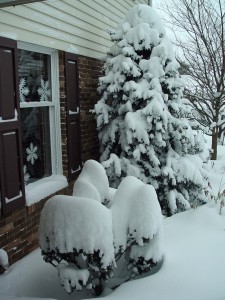Plants and the storms
February 10th, 2010
This is getting ridiculous now. I can’t even see my compost bin anymore, much less dump peelings into it. That’s assuming I could even open the back door to get out. We haven’t had this much snow since those back-to-back storms about a dozen Januaries ago when we ended up with 40 inches.
It’ll take awhile for all of this to melt. So I guess that’ll do it for getting a February jump on any yard jobs like edging and pruning. We’ll be lucky if it’s all gone in time to plant tomatoes.

My evergreens out front look more like big white Popsicles. They'll be fine, though. I'm not cleaning them off.
I’m not a big snow fan, but it does have benefits in the landscape.
On the one hand, the sheer weight of the snow – coupled by wind – can rip limbs off of trees and split trunks. My evergreens are sagging and groaning under the load.
On the other hand, snow is great winter insulation that protects the crowns (growing points) of borderline-hardy plants, keeps the rootballs of young plants from “heaving” out of the ground during freezes and thaws, and shields the leaves of evergreen shrubs from cold, drying winter winds.
Your top priority around the yard now should be removing any large, dangling branches that pose a threat. These are ones that could fall on your house, car or a person passing underneath.
Don’t attempt to do this yourself if you have to leave the ground! An accident waiting to happen is a gardener in snow boots on a ladder with a chainsaw. Hire a pro. They’re trained, and they’ve got the safety equipment. And insurance.
Prune off cracked branches you can reach back to the nearest undamaged branch or to just outside the little ring where the branch attaches to the trunk. Avoid letting behind stubs that will die and possibly become diseased.
Smaller snapped branches that don’t pose a threat can be removed later, before new growth begins in spring.
Don’t worry too much about sagging evergreens and flowering shrubs. It’s amazing how well they spring back to shape once the snow load melts and the weather warms. For most of them, you won’t have to do anything.
If you’ve got a real sagger, gently brush the snow off with a broom or with your hands. Use an upward motion. You’ll break the branches by whacking them from the top. Remember, the branches are cold and brittle, and the snow may even be melted onto the leaves and stems. If you’re not careful, you may do more damage trying to get the snow off than just letting nature take its course.
Branches that are still sagging after things warm up in spring can be pulled back together using commercial tree ties (available in some garden centers) or old nylon stockings. The key is using soft material that won’t cut into the bark like wire or rope would do.
A bigger threat to foundation shrubs is when huge sheets of melting ice and snow slide off the roof. That kind of sudden weight can easily tear whole sides off a young boxwood or azalea.
Again, even most of that damage is fixable with some spring pruning and patience.
Wrapping at-risk shrubs in a “straitjacket” of burlap will give them support and some protection. Some people even build little plywood lean-to’s over favorite foundation shrubs that are planted in spots where snow often slides off.
As with the chainsaw/ladder idea, going up on the roof to shovel is not a great idea.
What about those daffodil shoots that poked up a few inches already? No worry… the deep snow cover won’t hurt them a bit. In fact, it’s better for them at this stage than being exposed to the air.
Although overnight temperatures in the teens won’t hurt the actual daffodil flowers (the buds are still safely tucked underground), frigid winter wind can brown out the leaf tips that have emerged.
The snow cover also will make sure that no other bulbs try to poke up before their time, as happens in unusually warm spells in late winter.







